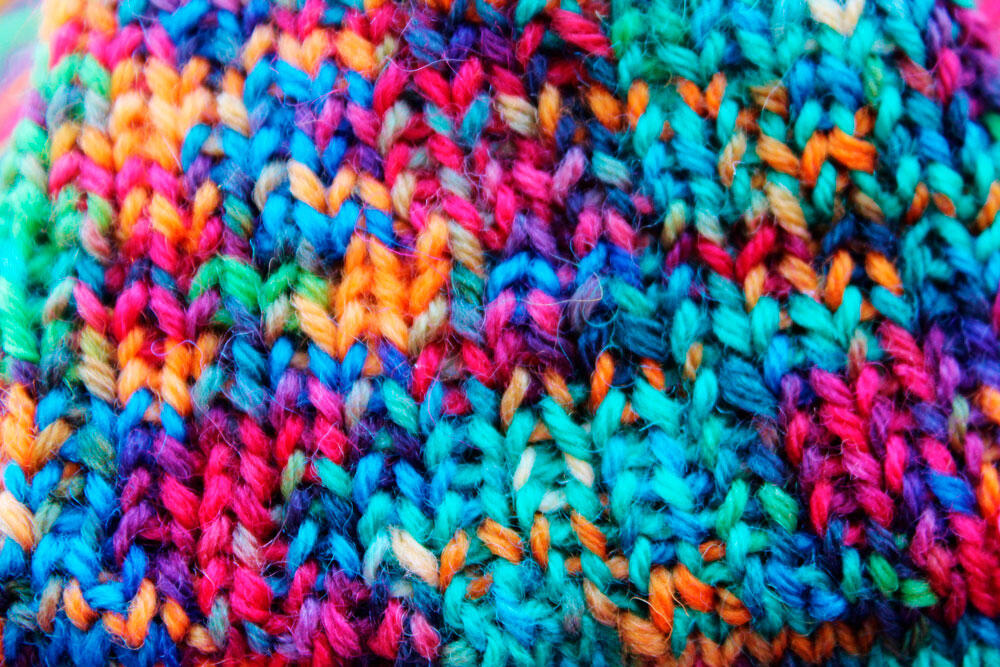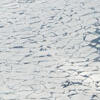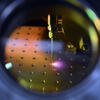You are here
Knitted fabric, an everyday metamaterial

While research in physics is often associated with giant technical infrastructure such as the LHC, it can also focus on everyday objects. “I have long taken a strong interest in everyday materials with extraordinary properties,” explains Audrey Steinberger, a CNRS researcher at the Physics Laboratory1. “My original motivation for studying physics goes back to secondary school, when I learned that a solid is normally more dense that its liquid phase, yet inversely ice floats on water.”
From textile to metamaterial
This interest continued up through her PhD thesis and beyond. It was actually during her postdoctoral fellowship that Steinberger took an interest in the surprising properties of a material that is at first glance not very exotic: knitted fabric. “One of my colleagues was a knitting addict, and taught me how to knit. Knitted fabric is simultaneously light, resistant, and extremely deformable, and it is quite rare to possess all of these properties at the same time. So I began to ask myself lots of questions from the standpoint of materials physics.”

These questions have since become a genuine research project. “When I compare myself to researchers in textile mechanics, I see that our approaches are very different,” Steinberger explains. “They are interested in the details of the material, whereas I am looking for minimal models in which I no longer see knitted fabric as a textile, but as a frictional metamaterial. I focus on knitted fabric, but in actual fact, it is metamaterials and assemblies of disordered fibres that I study.”
The deformability of knitted fabric comes from its structure, in which a thread forms interlacing loops, also called stitches. When a sweater or sock is deformed, it is the loops that deform, not the thread itself. “This is a crucial detail. Incidentally, an artificial material whose properties are dictated by its structure is known as a metamaterial. These are normally cutting-edge objects produced in laboratories, whereas knitted fabrics are part of everyday life.”
The secret of Jersey stitch
In an article recently published2 with Jérôme Crassous, a professor at Université de Rennes and member of the IPR institute of physics3, and Samuel Poincloux, an assistant professor at Aoyama Gakuin University (Japan), Steinberger presents a study conducted on Jersey stitch knit, the most common production method, and the easiest to produce with industrial machines. This research is based on the numerical modelling of frictional fibre systems designed by Crassous, as well as an experimental system developed by Steinberger to verify and confirm the simulated results.
A first observation is that the knitted sweater (or sock) possesses multiple forms of equilibrium. The sweater adopts the shape of the body, and can be folded to be stored flat, easily changing from one shape to another. However, if you pull too hard on a sock, it will retain part of this deformation. There are therefore multiple possible states of equilibrium that the knitted fabric can conserve without the influence of external forces, unlike a latex glove, which will always return to its original shape. The general shape of a knitted fabric actually depends on the history of its deformations.
Steinberger and her colleagues have shown that this memory comes from solid friction at the contact points between threads. “If you put a notepad on a copy of CNRS le Journal magazine and tilt it, the notepad will initially be held in place by its solid friction, until the angle becomes too large and the notepad begins to slide. This notion is also present with avalanches and granular environments. We proved that a similar concept occurs with knitted fabrics, which keep their shape in the absence of external forces. However, unlike traditional elastic objects, multiple equilibrium configurations exist for knitted fabrics.”
Socks and points of equilibrium
The geometry of knitted fabrics – a network of interlacing loops – is defined by the relation between the diameter of the thread and its length within each stitch. All knitted fabrics with the same relation will have a similar behaviour from the standpoint of physics. The knitted fabric’s shape is thus determined by the dimensions of the rectangle made by the stitch, measured with regard to the length of thread per stitch: each rectangular form corresponds to a particular point of equilibrium for the knitted fabric at rest. What is more, as friction increases, so do the number of possible points of equilibrium.

“Samuel Poincloux wanted to know whether there was a well-defined state of equilibrium, and we found there were several. But one of them is remarkable: the terminal point can serve as a reference for all sorts of mechanical experiments on the knitted fabric. It allows us to conduct reproducible research, and to better compare results. This is what was missing up to now in research on knitted fabric.”
This work also enabled the researchers to explain why knitted socks are comfortable, tight around the ankles, but less so elsewhere. This configuration is made possible by the existence of different points of equilibrium, with the whole being held together through friction. These findings are still too fundamental to be used by the textile industry, but they open up a new area of research that could help develop new shock-absorbing and anti-vibration materials. ♦
- 1. CNRS / ENS Lyon.
- 2. https://arxiv.org/abs/2404.07811
- 3. CNRS / Université de Rennes.
Explore more
Author
A graduate from the School of Journalism in Lille, Martin Koppe has worked for a number of publications including Dossiers d’archéologie, Science et Vie Junior and La Recherche, as well the website Maxisciences.com. He also holds degrees in art history, archaeometry, and epistemology.














